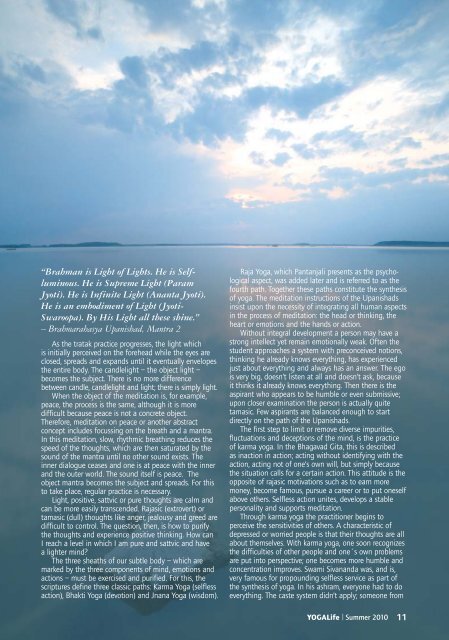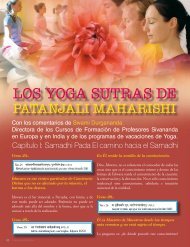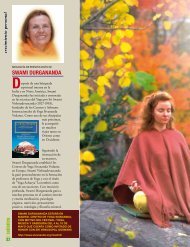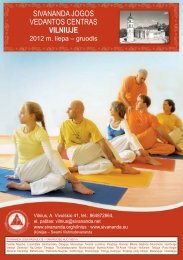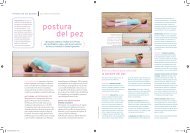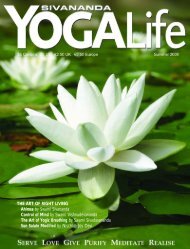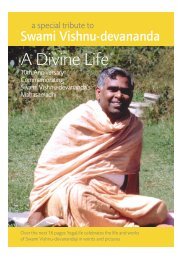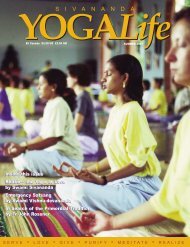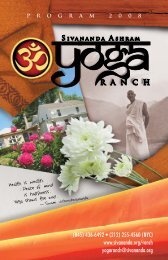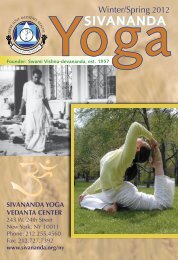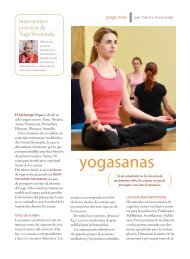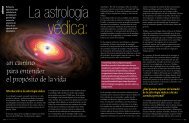YOGALife I Summer 2010 - Sivananda Yoga
YOGALife I Summer 2010 - Sivananda Yoga
YOGALife I Summer 2010 - Sivananda Yoga
You also want an ePaper? Increase the reach of your titles
YUMPU automatically turns print PDFs into web optimized ePapers that Google loves.
“Brahman is Light of Lights. He is Selfluminous.<br />
He is Supreme Light (Param<br />
Jyoti). He is Infinite Light (Ananta Jyoti).<br />
He is an embodiment of Light (Jyoti-<br />
Swaroopa). By His Light all these shine.”<br />
– Brahmarahasya Upanishad, Mantra 2<br />
As the tratak practice progresses, the light which<br />
is initially perceived on the forehead while the eyes are<br />
closed, spreads and expands until it eventually envelopes<br />
the entire body. The candlelight – the object light –<br />
becomes the subject. There is no more difference<br />
between candle, candlelight and light; there is simply light.<br />
When the object of the meditation is, for example,<br />
peace, the process is the same, although it is more<br />
difficult because peace is not a concrete object.<br />
Therefore, meditation on peace or another abstract<br />
concept includes focussing on the breath and a mantra.<br />
In this meditation, slow, rhythmic breathing reduces the<br />
speed of the thoughts, which are then saturated by the<br />
sound of the mantra until no other sound exists. The<br />
inner dialogue ceases and one is at peace with the inner<br />
and the outer world. The sound itself is peace. The<br />
object mantra becomes the subject and spreads. For this<br />
to take place, regular practice is necessary.<br />
Light, positive, sattvic or pure thoughts are calm and<br />
can be more easily transcended. Rajasic (extrovert) or<br />
tamasic (dull) thoughts like anger, jealousy and greed are<br />
difficult to control. The question, then, is how to purify<br />
the thoughts and experience positive thinking. How can<br />
I reach a level in which I am pure and sattvic and have<br />
a lighter mind?<br />
The three sheaths of our subtle body – which are<br />
marked by the three components of mind, emotions and<br />
actions – must be exercised and purified. For this, the<br />
scriptures define three classic paths: Karma <strong>Yoga</strong> (selfless<br />
action), Bhakti <strong>Yoga</strong> (devotion) and Jnana <strong>Yoga</strong> (wisdom).<br />
Raja <strong>Yoga</strong>, which Pantanjali presents as the psycho -<br />
logical aspect, was added later and is referred to as the<br />
fourth path. Together these paths constitute the synthesis<br />
of yoga. The meditation instructions of the Upanishads<br />
insist upon the necessity of integrating all human aspects<br />
in the process of meditation: the head or thinking, the<br />
heart or emotions and the hands or action.<br />
Without integral development a person may have a<br />
strong intellect yet remain emotionally weak. Often the<br />
student approaches a system with preconceived notions,<br />
thinking he already knows everything, has experienced<br />
just about everything and always has an answer. The ego<br />
is very big, doesn’t listen at all and doesn’t ask, because<br />
it thinks it already knows everything. Then there is the<br />
aspirant who appears to be humble or even submissive;<br />
upon closer examination the person is actually quite<br />
tamasic. Few aspirants are balanced enough to start<br />
directly on the path of the Upanishads.<br />
The first step to limit or remove diverse impurities,<br />
fluctuations and deceptions of the mind, is the practice<br />
of karma yoga. In the Bhagavad Gita, this is described<br />
as inaction in action; acting without identifying with the<br />
action, acting not of one’s own will, but simply because<br />
the situation calls for a certain action. This attitude is the<br />
opposite of rajasic motivations such as to earn more<br />
money, become famous, pursue a career or to put oneself<br />
above others. Selfless action unites, develops a stable<br />
personality and supports meditation.<br />
Through karma yoga the practitioner begins to<br />
perceive the sensitivities of others. A characteristic of<br />
depressed or worried people is that their thoughts are all<br />
about themselves. With karma yoga, one soon recognizes<br />
the difficulties of other people and one´s own problems<br />
are put into perspective; one becomes more humble and<br />
concentration improves. Swami <strong>Sivananda</strong> was, and is,<br />
very famous for propounding selfless service as part of<br />
the synthesis of yoga. In his ashram, everyone had to do<br />
everything. The caste system didn’t apply; someone from<br />
<strong>YOGALife</strong> I <strong>Summer</strong> <strong>2010</strong> 11


